July 1, 2022
The Little Brown Church in the Vale
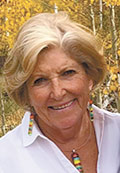 By Mary Schricker Gemberling
By Mary Schricker Gemberling
“History is a story written by the finger of God.”
… C.S. Lewis
Gary and I have driven the 300 mile journey to Dodge Center Minnesota many times since his daughter and family moved there just over 10 years ago. At exit 220 on US 63 there is a small sign identifying the turn to the Little Brown Church. We have often commented that someday we should visit the historical site. Earlier this month we decided to do just that. We were pleased to find a quaint country church in a picturesque setting with a rich history dating back 167 years.
The first settlers came to the Bradford area in 1848 and with an abundant water supply and virgin timber, the town grew. By 1855 the first members of the Puritan-Congregational Church had begun holding meetings. By 1856, Bradford had 500 residents and was the first town in that part of Iowa. A young music teacher named William Pitts was traveling by stagecoach from Wisconsin to Iowa to visit his future wife. While waiting for the stagecoach horses to be changed, he walked down Cedar Street and saw the empty lot where the church now stands. Being a romantic young man, he thought what a charming setting the spot would make for a church. Returning home, he wrote the poem “Church in the Wildwood,” and later set it to music. He put it away in a drawer and forgot about it.
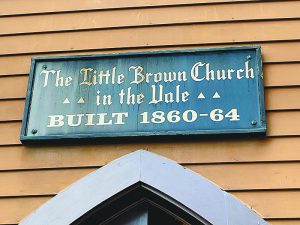
By all reports Bradford was a wild town and as the population grew, the demand for a house of worship and a school became evident. As the school was deemed more important, the Bradford Academy was built, and the church folk met on Sundays in the upstairs classrooms. As Bradford grew into quite a metropolis the need for a designated worship building became more critical, but it wasn’t until the spring of 1860 that the plans were made. When Rev. Nutting arrived, talk of building became more serious, and a parish family donated the property. Limestone was quarried and the foundation was laid. The Civil War slowed the work, but when one family gave trees and another donated the sawing of the lumber, the work never really ceased. By 1862 the building was enclosed. When it came time to paint the building, the cheap, drab brown Ohio Mineral Paint, which would protect the wood, was chosen.
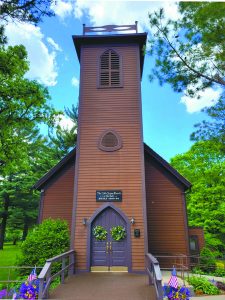 Meanwhile, Mr. Pitts had married and was living in Wisconsin. In 1862 he and his wife moved to Fredericksburg, Iowa to be near her elderly parents, and Mr. Pitts was hired to teach singing classes at the Bradford Academy. Imagine his surprise when he saw a little brown church nestled in the very trees where he had stood some years before. He went home and found the song and taught it to his class who sang it at the dedication service of the church. Pitts had written a song for a church that wasn’t there. The congregation had painted their little church brown without ever hearing the song. Dr. Pitt’s song found popularity late in the 1800s when the singing team of Arthur Champion and Charles Alexander made a world tour. When the tour reached New Zealand and Australia the song became so popular the group used it as their theme song.
Meanwhile, Mr. Pitts had married and was living in Wisconsin. In 1862 he and his wife moved to Fredericksburg, Iowa to be near her elderly parents, and Mr. Pitts was hired to teach singing classes at the Bradford Academy. Imagine his surprise when he saw a little brown church nestled in the very trees where he had stood some years before. He went home and found the song and taught it to his class who sang it at the dedication service of the church. Pitts had written a song for a church that wasn’t there. The congregation had painted their little church brown without ever hearing the song. Dr. Pitt’s song found popularity late in the 1800s when the singing team of Arthur Champion and Charles Alexander made a world tour. When the tour reached New Zealand and Australia the song became so popular the group used it as their theme song.
The town of Bradford continued to prosper until the railroad passed it by locating instead in Nashua. Eventually, like many early settlements Bradford ceased to exist, and by 1900 the church looked like it had suffered the same fate as the town. The congregation had mostly moved away and visiting pastors met with those who remained in their homes. Only the Sunday school continued to meet. After a few years a group of area people, calling themselves the “Society for the Preservation of the Little Brown Church” were determined to repair the church and once again hold regular services. In March of 1914 Reverend Burleigh of the nearby Nashua Congregational church held two weeks of Revival Meetings and the Little Brown Church added thirty new members to their rolls. In June of 1916 a reunion was held with both Dr. Pitts and Reverend Nutting returning to the church. This was the first of many reunions to be held. Over the years renovations have continued both inside and on the surrounding grounds.
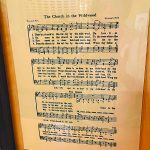 Just as the church received a new breath of life, so did its namesake song. In 1910 the Weatherwax Brothers Quartet used “The Church in the Wildwood” as their theme song. Lester Weatherwax wrote: “The song seemed to be just another song and the Church just another country church. My brothers and I introduced it into our mostly classical program during our tours. At first we ‘hid it away’ but later it became the hub around which our programs were built. We sang the song and with each singing told the story of Dr. Pitts writing the song and the location of the REAL Church in the Wildwood. We only lived 12 miles from there and knew the story well.” After World War I highways were improved and cars brought many visitors. Some of those visiting the church were war veterans who had heard the song while serving overseas and vowed if they survived to find the church that had been a message of hope from home.
Just as the church received a new breath of life, so did its namesake song. In 1910 the Weatherwax Brothers Quartet used “The Church in the Wildwood” as their theme song. Lester Weatherwax wrote: “The song seemed to be just another song and the Church just another country church. My brothers and I introduced it into our mostly classical program during our tours. At first we ‘hid it away’ but later it became the hub around which our programs were built. We sang the song and with each singing told the story of Dr. Pitts writing the song and the location of the REAL Church in the Wildwood. We only lived 12 miles from there and knew the story well.” After World War I highways were improved and cars brought many visitors. Some of those visiting the church were war veterans who had heard the song while serving overseas and vowed if they survived to find the church that had been a message of hope from home.
When a school superintendent and a merchant’s daughter were married in the church, a new tradition of ringing the bell was started. It was a means to proclaim a wedding and pronounce blessings on the new couple. Word continued to spread and couples came from near and far to get married and ring the bell in ‘The Little Brown Church in the Vale’. To date more than 76,000 couples have been married in the church and it continues to be the number one destination for weddings in the Midwest. It remains as it was founded, a Congregational church. The song continues to be sung as the response to the Benediction in a little church that is painted brown and sits in the wildwood.
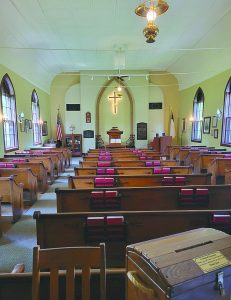 On the list of past ministers of the Little Brown Church you will find the name of John W. Christy who served the church from 1978 to 1986. In his years at the church Reverend Christy presided over an average of 600 weddings a year. After retiring from the ministry John and his wife Marilyn moved to Davenport, Iowa. In their later years they lived with their son and daughter in law, Mark and Becky Christy, in a house down the street from me. I remember John as a great story teller who loved to reminisce. I do remember him talking about his days at the Little Brown Church; I wished I would have payed closer attention!
On the list of past ministers of the Little Brown Church you will find the name of John W. Christy who served the church from 1978 to 1986. In his years at the church Reverend Christy presided over an average of 600 weddings a year. After retiring from the ministry John and his wife Marilyn moved to Davenport, Iowa. In their later years they lived with their son and daughter in law, Mark and Becky Christy, in a house down the street from me. I remember John as a great story teller who loved to reminisce. I do remember him talking about his days at the Little Brown Church; I wished I would have payed closer attention!
“There’s a church in the valley by the wildwood, No lovelier spot in the dale; No place is so dear to my childhood as the little brown church in the vale…………”
—Mary Schricker Gemberling
Mary, a former educator and Seniors Real Estate Specialist is the author of four books: The West End Kid, A Labor of Love; My Personal Journey through the World of Caregiving, Hotel Blackhawk; A Century of Elegance, and Ebenezer United Methodist Church: One hundred fifty years of Resiliency.


